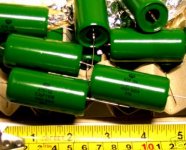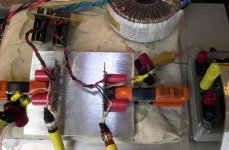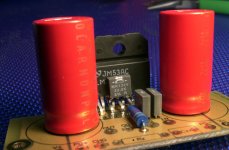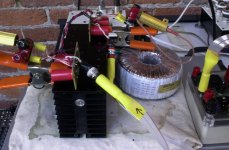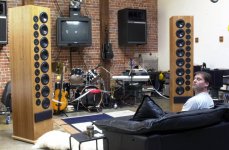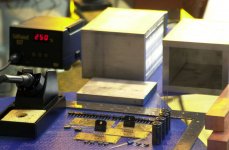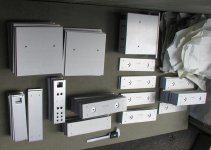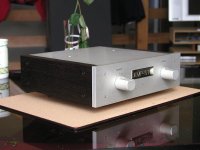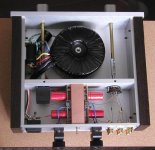Hi Peter
You don't have the Plitron transformers on your website at present - what are the prices and shipping to UK?
I notice the Plitron site has some specialised audio toroids, albeit starting at 500VA, designed with low noise in mind. Any experience with these?
All the best
Colin
You don't have the Plitron transformers on your website at present - what are the prices and shipping to UK?
I notice the Plitron site has some specialised audio toroids, albeit starting at 500VA, designed with low noise in mind. Any experience with these?
All the best
Colin
DAC Coupling Caps
Hi Peter,
I've been researching the availability of audio grade capacitors in the 2.0 to 4.7uf range to do some experimenting. As I'm sure you are aware the selection is not great.
The Auricaps, Mundorfs, V-Caps, etc., are quite large (as well as expensive).
Do you have a preference between polarized and non-polarized?
And lastly, are tantalum capacitors an acceptable choice for coupling caps on the DAC.....I never see them being used in such an application and was wondering why? Is there an ESR or inductance problem with them? They seem to have pretty good availability in this capacitance range, and they are compact.
Robert
Hi Peter,
I've been researching the availability of audio grade capacitors in the 2.0 to 4.7uf range to do some experimenting. As I'm sure you are aware the selection is not great.
The Auricaps, Mundorfs, V-Caps, etc., are quite large (as well as expensive).
Do you have a preference between polarized and non-polarized?
And lastly, are tantalum capacitors an acceptable choice for coupling caps on the DAC.....I never see them being used in such an application and was wondering why? Is there an ESR or inductance problem with them? They seem to have pretty good availability in this capacitance range, and they are compact.
Robert
Re: DAC Coupling Caps
300 VA Standard toroid is USD$80 (current Plitron pricing). Shipping to UK is either CAD$50 by surface or $92 air (4kg). I never tried those LoNoise units, I'm having amorphous core toroids cutom built in Europe instead.
I never tried current production tantalums, I don't expect those would be any good. However, when I was modifying Accuphase 101 tuner, those old type blue tantalums appeared better for coupling than BG N.
It's alsways better to use nonpolarized caps in coupling. Here's a link to interesting comparison between capacitors: http://www.humblehomemadehifi.com/Cap.html
Colin said:You don't have the Plitron transformers on your website at present - what are the prices and shipping to UK?
I notice the Plitron site has some specialised audio toroids, albeit starting at 500VA, designed with low noise in mind. Any experience with these?
300 VA Standard toroid is USD$80 (current Plitron pricing). Shipping to UK is either CAD$50 by surface or $92 air (4kg). I never tried those LoNoise units, I'm having amorphous core toroids cutom built in Europe instead.
rjkdivin said:Hi Peter,
I've been researching the availability of audio grade capacitors in the 2.0 to 4.7uf range to do some experimenting. As I'm sure you are aware the selection is not great.
The Auricaps, Mundorfs, V-Caps, etc., are quite large (as well as expensive).
Do you have a preference between polarized and non-polarized?
And lastly, are tantalum capacitors an acceptable choice for coupling caps on the DAC.....I never see them being used in such an application and was wondering why? Is there an ESR or inductance problem with them? They seem to have pretty good availability in this capacitance range, and they are compact.
I never tried current production tantalums, I don't expect those would be any good. However, when I was modifying Accuphase 101 tuner, those old type blue tantalums appeared better for coupling than BG N.
It's alsways better to use nonpolarized caps in coupling. Here's a link to interesting comparison between capacitors: http://www.humblehomemadehifi.com/Cap.html
Re: Re: DAC Coupling Caps
I recently replaced a pair of those blue tantalums in a 2A3 amp with Ven-Haus OIMP V-Caps with great results.
Though not updated in a while, this is another interesting page on audio capacitors. Interesting how he describes how film caps break-in and self-heal, or not...:
http://ldsg.snippets.org/appdx-ec.php3
-Rob
Peter Daniel said:
It's alsways better to use nonpolarized caps in coupling. Here's a link to interesting comparison between capacitors: http://www.humblehomemadehifi.com/Cap.html
I recently replaced a pair of those blue tantalums in a 2A3 amp with Ven-Haus OIMP V-Caps with great results.
Though not updated in a while, this is another interesting page on audio capacitors. Interesting how he describes how film caps break-in and self-heal, or not...:
http://ldsg.snippets.org/appdx-ec.php3
-Rob
Re: DAC Coupling Caps
How about 50 cents each? Of course you have to buy 30 of 'em and they cost $24 to ship from the Ukraine...
There's still a bunch of Russian military NOS caps on the market, available on eBay. As evidenced by this search:
http://tinyurl.com/mrxpx
I've got a slew of the K40 PIOs in .22uf/1000V value en route from the Ukraine. They say they ship airmail, I'm thinking they must be using a Zeppelin.
None the less, legend has it these things equal or exceed the pricey REL TFT Exoticas and V-CAPS. Folks jest that Richard Marsh of RELCap and Chris VenHaus of V-Cap can't wait for th supply to dry up.
They are still big, esp. the glass-encapsulated designs. But with caps, there's no free lunch on size.
Here's a listing for thirty 2.2uF/400V PIOs for $15.00.
http://tinyurl.com/qc2zg
If anyone gets some, I'll trade you some of my .22s for another value.
-Rob
rjkdivin said:
I've been researching the availability of audio grade capacitors in the 2.0 to 4.7uf range to do some experimenting. As I'm sure you are aware the selection is not great.
The Auricaps, Mundorfs, V-Caps, etc., are quite large (as well as expensive).
How about 50 cents each? Of course you have to buy 30 of 'em and they cost $24 to ship from the Ukraine...
There's still a bunch of Russian military NOS caps on the market, available on eBay. As evidenced by this search:
http://tinyurl.com/mrxpx
I've got a slew of the K40 PIOs in .22uf/1000V value en route from the Ukraine. They say they ship airmail, I'm thinking they must be using a Zeppelin.
None the less, legend has it these things equal or exceed the pricey REL TFT Exoticas and V-CAPS. Folks jest that Richard Marsh of RELCap and Chris VenHaus of V-Cap can't wait for th supply to dry up.
They are still big, esp. the glass-encapsulated designs. But with caps, there's no free lunch on size.
Here's a listing for thirty 2.2uF/400V PIOs for $15.00.
http://tinyurl.com/qc2zg
If anyone gets some, I'll trade you some of my .22s for another value.
-Rob
Attachments
Another PDGC is born...
I finally got around to putting together a PDGC yesterday. I used the premium kit with the BG caps per the Patek, one rectifier board and a massive dual 22V/400VA Antec toroid (c. $44).
No chassis yet. Clamped the chips to a 1/2" block of aluminum and fired it up. Right off the bat it sounds terrific into my 97dB ORCA designed custom line arrays. (Funny to see a little pile of parts bowl you over through 800lbs of speakers.)
Have been burning in the amp since last night with a FryKleaner on high with a pair of 8 Ohm Mills 50W power resistors on the outputs. Next listen should be interesting...
While burning in I could fry a little quails egg on the aluminum plate until I recently placed a big heat sink under it.
I've been listening to modded Wright 2A3 monos, a modded Music Reference RM-9 100 WPC KT-88 PP amp and a Spectron Musician II as references. This little PD GC is a contender, the detail of the 2A3, the dynamics of the PP tubes and the slam of the 600 WPC Spectron?!!!
More to come...
I finally got around to putting together a PDGC yesterday. I used the premium kit with the BG caps per the Patek, one rectifier board and a massive dual 22V/400VA Antec toroid (c. $44).
No chassis yet. Clamped the chips to a 1/2" block of aluminum and fired it up. Right off the bat it sounds terrific into my 97dB ORCA designed custom line arrays. (Funny to see a little pile of parts bowl you over through 800lbs of speakers.)
Have been burning in the amp since last night with a FryKleaner on high with a pair of 8 Ohm Mills 50W power resistors on the outputs. Next listen should be interesting...
While burning in I could fry a little quails egg on the aluminum plate until I recently placed a big heat sink under it.
I've been listening to modded Wright 2A3 monos, a modded Music Reference RM-9 100 WPC KT-88 PP amp and a Spectron Musician II as references. This little PD GC is a contender, the detail of the 2A3, the dynamics of the PP tubes and the slam of the 600 WPC Spectron?!!!
More to come...
Attachments
Re: Another PDGC is born...
I must say, for anyone who hasn't delved into DIY and is looking for a place to start, this project is so easy, the price so low and the results so worthwhile, that this is the way to get your feet wet.
I started DIY building kits in the early 70s with SWTP Tiger .01 amps, and have always enjoyed it. The renegade, true DIY nature of the PD project is even more appealing to me that a traditional "kit". The only challenge in this kit would be doing the NFB Caddock on the chip legs, which you don't have to do, but for me was the most fun...
Here's a pic of one channel with NFB resistor on the amp chip:
I must say, for anyone who hasn't delved into DIY and is looking for a place to start, this project is so easy, the price so low and the results so worthwhile, that this is the way to get your feet wet.
I started DIY building kits in the early 70s with SWTP Tiger .01 amps, and have always enjoyed it. The renegade, true DIY nature of the PD project is even more appealing to me that a traditional "kit". The only challenge in this kit would be doing the NFB Caddock on the chip legs, which you don't have to do, but for me was the most fun...
Here's a pic of one channel with NFB resistor on the amp chip:
Attachments
Re: Re: Another PDGC is born...
Peter,
I think I reversed the orientation of the BG N caps at the chips from what you do on the Patek.
Does it indeed make a difference and can you describe it sonically?
And Bravo on your execution.
-Rob
Rob Thomas said:
Here's a pic of one channel with NFB resistor on the amp chip:
Peter,
I think I reversed the orientation of the BG N caps at the chips from what you do on the Patek.
Does it indeed make a difference and can you describe it sonically?
And Bravo on your execution.
-Rob
Re: Re: Re: Another PDGC is born...
Yes, it makes a difference. With one way, it's more focused, and it seems more accurate, sort of like playing with signal polarity. Even if you cut the pins, you can still identify the sides, as NONPOLAR print is always on the side of shorter pin (+ by my preference).
There is an easy way to install feedback resistor on my boards: http://www.diyaudio.com/forums/showthread.php?postid=584427#post584427
Later, you can also try shorting 220R series input resistor, it usually sounds better without it (and I'm not using that resistor in Patek amp).
Rob Thomas said:Does it indeed make a difference and can you describe it sonically?
Yes, it makes a difference. With one way, it's more focused, and it seems more accurate, sort of like playing with signal polarity. Even if you cut the pins, you can still identify the sides, as NONPOLAR print is always on the side of shorter pin (+ by my preference).
There is an easy way to install feedback resistor on my boards: http://www.diyaudio.com/forums/showthread.php?postid=584427#post584427
Later, you can also try shorting 220R series input resistor, it usually sounds better without it (and I'm not using that resistor in Patek amp).
Re: Another PDGC is born...
After about 20 hours on the FryKleaner and then clamping the modules onto an actual heat sink I fired up some rock before my sole neighbor got home.
Led Zeppelin II "Whole Lotta Love" and Talking Heads '77 Psycho killer, on vinyl, through an all tube Wright AG Phono stage directly into Peter's Gain Clones and then on to 400 lb each, 97dB efficient ORCA/Zalytron AXON custom line arrays. See pic. (The ultimate DIY speaker? I didn't build them, I wish I could do such cabinet work.)
Good gracious. The AG phono has built in gain controls, at 6 o'clock, which is about the minimum gain for some amps, the in-room response measured 102dB peaks on Zep and 104dB on the heads. This while maintaining insanely tight and deep bass control, and throughout, vocals, cymbals were clear and pristine..., and LOUD. Whole Lotta Love was doing the wrap around 360 degree imaging that was downright scary and unlike I've ever heard from stereo, (I'm still getting used to what these arrays can do, listening nearfield at about 2M.)
Very impressive amp this is, I suspect the BG upgrades and quality 400VA toroid don't hurt.
The "amp" stays quite cool now clamped to the heatsink versus the chunk of aluminum.
(For more on the speakers, See Zalytron.com scroll dow past kits to Line Arrays, click on details for the Axon 812 Arrays, the speakers described and depicted are the very same pair now residing in my loft. Jon, the guy who built them and describes them on the Zalytron site is a GC and did a great job, 24 countersunk tweeters, beautiful cherry veneer over 1.5" MDF, hence 400 lbs each. Drivers and crossover components are about a grand. Compare to the big Dali's, Pipedreams and the new McIntosh arrays...)
-Rob
Rob Thomas said:
More to come...
After about 20 hours on the FryKleaner and then clamping the modules onto an actual heat sink I fired up some rock before my sole neighbor got home.
Led Zeppelin II "Whole Lotta Love" and Talking Heads '77 Psycho killer, on vinyl, through an all tube Wright AG Phono stage directly into Peter's Gain Clones and then on to 400 lb each, 97dB efficient ORCA/Zalytron AXON custom line arrays. See pic. (The ultimate DIY speaker? I didn't build them, I wish I could do such cabinet work.)
Good gracious. The AG phono has built in gain controls, at 6 o'clock, which is about the minimum gain for some amps, the in-room response measured 102dB peaks on Zep and 104dB on the heads. This while maintaining insanely tight and deep bass control, and throughout, vocals, cymbals were clear and pristine..., and LOUD. Whole Lotta Love was doing the wrap around 360 degree imaging that was downright scary and unlike I've ever heard from stereo, (I'm still getting used to what these arrays can do, listening nearfield at about 2M.)
Very impressive amp this is, I suspect the BG upgrades and quality 400VA toroid don't hurt.
The "amp" stays quite cool now clamped to the heatsink versus the chunk of aluminum.
(For more on the speakers, See Zalytron.com scroll dow past kits to Line Arrays, click on details for the Axon 812 Arrays, the speakers described and depicted are the very same pair now residing in my loft. Jon, the guy who built them and describes them on the Zalytron site is a GC and did a great job, 24 countersunk tweeters, beautiful cherry veneer over 1.5" MDF, hence 400 lbs each. Drivers and crossover components are about a grand. Compare to the big Dali's, Pipedreams and the new McIntosh arrays...)
-Rob
Attachments
Re: Re: Re: Re: Another PDGC is born...
I left the BG non-polar cap pins a hair long knowing I might try flipping them. I noticed they still indicate the inner and outer foil conventionally. Out of curiosity, does anyone know if negative inner or outer foil?
Easy enough to try, will do once I have a better handle on the sound of this fine device.
-Rob
Peter Daniel said:
Yes, it makes a difference. With one way, it's more focused, and it seems more accurate, sort of like playing with signal polarity. Even if you cut the pins, you can still identify the sides, as NONPOLAR print is always on the side of shorter pin (+ by my preference).
I left the BG non-polar cap pins a hair long knowing I might try flipping them. I noticed they still indicate the inner and outer foil conventionally. Out of curiosity, does anyone know if negative inner or outer foil?
Later, you can also try shorting 220R series input resistor, it usually sounds better without it (and I'm not using that resistor in Patek amp).
Easy enough to try, will do once I have a better handle on the sound of this fine device.
-Rob
Attachments
The Integrated amp chassis is back in stock.
There are few front panels without openings for the knobs, so they can be used for any application, not neccessarily Int amp; same for rear panels: I have at least 20 pcs with AC module opening only, so the chassis can be implemented as preamp enclosure only, or power amp only.
This time it's made even better, as top and bottom panels are 0.25 thick, and all panels are machined from plates, not extrusions.
The price is $250/set. There are few sets that have some minor imperfections, those may be available at discounted price.
All accesories (knobs, wooden sides, shaft extenders, feet etc.) are also available.
There are few front panels without openings for the knobs, so they can be used for any application, not neccessarily Int amp; same for rear panels: I have at least 20 pcs with AC module opening only, so the chassis can be implemented as preamp enclosure only, or power amp only.
This time it's made even better, as top and bottom panels are 0.25 thick, and all panels are machined from plates, not extrusions.
The price is $250/set. There are few sets that have some minor imperfections, those may be available at discounted price.
All accesories (knobs, wooden sides, shaft extenders, feet etc.) are also available.
Attachments
The circuitry in this amp is exactly as in Patek. This amp has additional toggle switch at the back that disconnects the pot completely from signal path. One set of inputs is connected directly to amp's input on the board, so it can be configured in power amp mode only (bypassing source selector and potentiometer).
Attachments
- Status
- This old topic is closed. If you want to reopen this topic, contact a moderator using the "Report Post" button.
- Home
- More Vendors...
- Audio Sector
- AudioSector-chip amp kits, dacs, chassis
